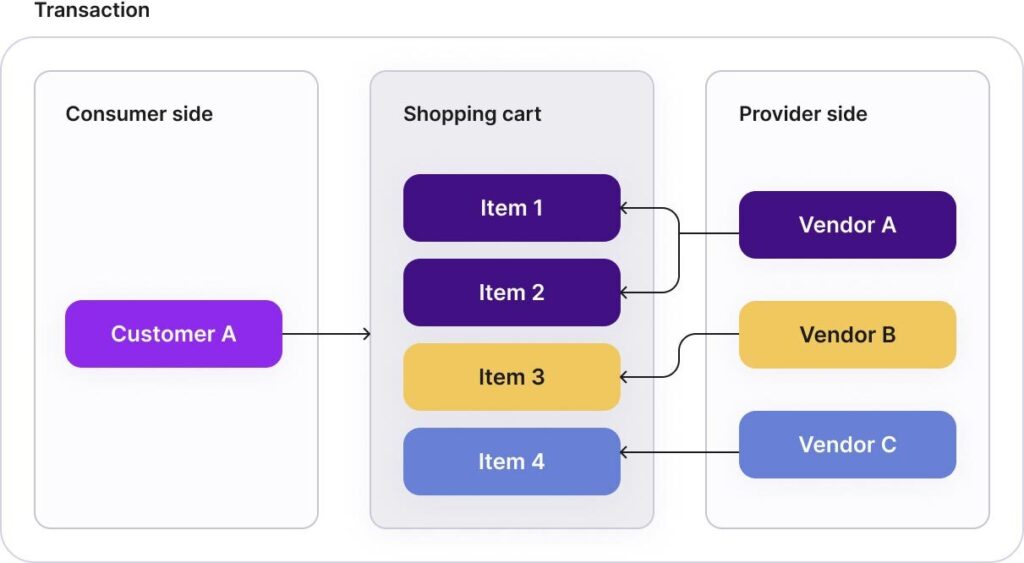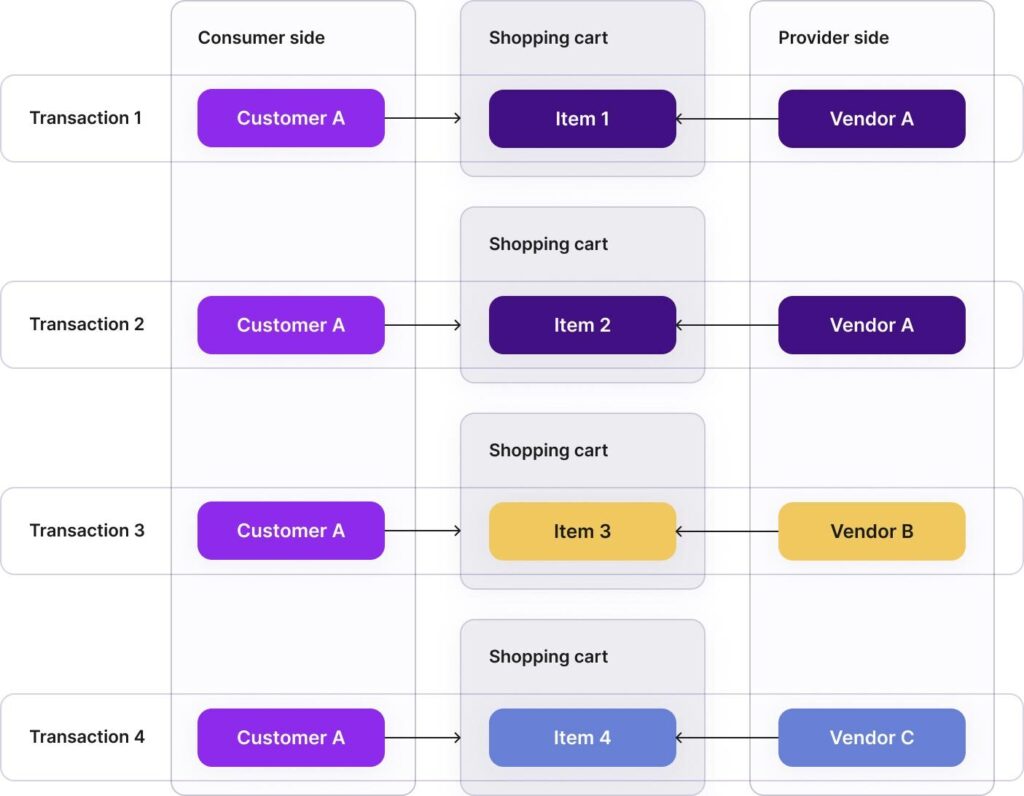I have met various individuals in the e-commerce sector: marketplace founders, heads of e-commerce looking to transform their online shops into marketplace, managers of existing businesses aiming to build platforms within a company group, and high aspiring individuals in traditional companies looking to transform their industry by creating platforms. Many believe that a multi-vendor system is an indispensable requirement.
They were asking if we are supporting that feature. We do, but as it turned out, they did not need it at all. Commonly, two reasons caused the confusion. First, lack of understanding what exactly is multi-vendor. Second, they did not validate their assumptions.
These conversations were the motivation for writing this article.
Imagine supermarkets as offline multi-vendor marketplace
Multi-vendor marketplaces are platforms where buyers have one checkout experience of purchasing goods and/or services from multiple sellers a.k.a. vendors. Popular multi-vendor marketplaces in the B2C space include Amazon, Etsy, Wayfair, and Alibaba.
In a physical world, a good analogy for a multi-vendor marketplace would be a supermarket. You put in your basket groceries from different vendors and pay for all of them at once. For example, you put cheese, bread, almonds, shrimps and then head to the cash register for the checkout. You have products from different brands a.k.a. vendors, but the cashier is not charging you separately for those products grouped by a vendor. Rather, you pay for all products at once.
An alternative to multi-vendor marketplaces is what we internally call many-vendor marketplaces.

Multi-vendor vs many-vendor marketplaces – different user journeys for the consuming side
Having multiple sellers a.k.a. vendors on your marketplace does not mean that you have a multi-vendor marketplace. It just means that you have a marketplace. At randevu.tech, we call it a many-vendor marketplace or simply a marketplace.
In a physical world, a good analogy for a many-vendor marketplace would be a shopping mall. In a shopping mall, you have different stores and probably several restaurants at the food court a.k.a. vendors.
However, as opposed to a supermarket, you do not checkout once when you are about to leave the shopping mall. Rather, you checkout separately with every vendor. If you buy shoes, you pay for them in that store. If you get food, you pay for it at the restaurant.
Think of AirBnB as an example of a many-vendor marketplace. You have many providers on the AirBnB a.k.a. vendors. Some of them offer accommodation and other ones offer tourist activities.
However, when you book something, you never book multiple accommodations and tourist activities at the same time, i.e. during one checkout experience.
For every purchase you make on AirBnB, you go through a dedicated checkout process. One after another. Subsequently.

Popular examples of many-vendor marketplaces are actually the majority of marketplaces out there.
If you have experience with AirBnB, you are probably thinking that AirBnB does not have a shopping cart at all and you are right. Later in the article, we will see if your use case needs a shopping cart experience or if you can go without it.
Single-vendor marketplace is an oxymoron – it does not exist
A marketplace that has only a single-vendor is not a marketplace. That is an online shop. That one vendor is probably yourself selling your own products or services.
If that is the case, then you do not need a tech that powers marketplaces. Of course, you can do that and onboard only yourself on the marketplace, but most probably you do not want to do that because that is a technical overkill.
No business case justifies such powerful tech unless you are planning to enable 3rd-party sellers, i.e. to open a marketplace. If you just want to sell online, then an online shop system is a good solution for you.
However, if you’re planning to open a marketplace in the mid or long term, you wouldn’t want to start with an online shop. Currently, a lot of online shop solutions offer a “marketplace module” which in my opinion is very limiting & expensive to modify. The reason is that a marketplace has a fundamentally different architecture than an online shop.
You can imagine it as a family car (online shop system) and a racing car (marketplace system). Of course, you can upgrade a family car to a racing car. However, that pimped family car is always going to be an inferior solution to a car that is by design made for racing.
I have met both marketplace founders, managers of enterprises that have to extend their e-commerce business into a marketplace business, and managers of existing businesses that build platforms within a company group, thinking that a multi-vendor is their indispensable requirement.
They were asking if we are supporting that feature. We do, but as it turned out, they did not need it at all. Commonly, two reasons caused the confusion. First, lack of understanding of what exactly is multi-vendor. Second, they did not validate their assumptions.
4 questions to ask to better understand if multi-vendor marketplace is for you
These conversations were the motivation for writing this article. What multi-vendor marketplaces are has been clarified so far in the article and for the second one, I ask the following questions.
- Can you imagine that your consumer side is going to purchase several items at the same time?
Is your use case similar to AirBnB, Bolt, Wolt, or UpWork? Is the purchase actually a “booking”? In those cases, the nature of the transaction does not require multi-vendor functionality. The consuming side purchases one item at a time. I want one accommodation. I need one ride. I want food from my favorite restaurant.
- If it would make sense to purchase several items at once, is that likely to happen?
Imagine a marketplace where expensive goods or services are transacted. For example, off-market real estate (e.g. shopping malls, stadiums) or airplanes. How likely is it that someone would purchase two different airplanes in one go? It’s not impossible, but I would argue it’s rather an exception than a rule.
- If it would make sense to purchase several items at once, do your consumer-side actually want it?
In B2B and wholesale commerce scenarios, you can easily imagine that a company would purchase multiple items from different vendors at the same time. You could imagine a similar buying experience of Amazon for your industry and you are 100% sure that this would skyrocket your platform.
These assumptions should be verified with the consuming side. It is not uncommon that your B2B consuming side actually does not need it. They want a nice purchasing journey on the platform, but it’s rare that they purchase from different vendors at the same time because that is not how they do business.
- Do you need a shopping cart at all?
What would happen if you would simplify the transaction process and modify the user journey from “add to cart” with “buy now”? You can hear people arguing that “buy now” is definitely a better journey because it includes less steps, less friction, and less possibility for a buyer to change their mind and give up on the purchase.
The better journey depends on your industry, consumer-side of your marketplace as well as type of goods and services that are being transacted.
If the goods and services are more expensive, shopping cart might be better because it removes fear of ordering by mistake. If you expect a high volume of low-priced goods and services, then probably “buy now” could be a better approach because if the consumer orders by mistake, that mistake is not so expensive for them. However, that is not a rule to follow blindly. For example, Alibaba sells a high volume of low-priced goods and still has a shopping cart.
How to build multi-vendor and different checkout experiences with randevu.tech
If randevu.tech powers your marketplace, you have different approaches to how you can build transaction flows on your platform.
The most important thing to remember is that r is that unlike with white-label solutions, you don’t have to choose a predefined experience and force your business to fit into it. Rather, you have the freedom to custom-build the transaction flow and experience that works for your industry.
Also, keep in mind that if you plan to expand internationally, different cultures might require different transaction flows, and randevu.tech is designed for such use cases.
You can also change those experiences as you learn from the market. Another use case to adopt your flows is when you grow into a multi-sided platform because typically you have a dedicated transaction flow for each pair of sides.
Concluding remarks
You have read about the difference between multi-vendor and many-vendor marketplaces with the analogy of a supermarket and a shopping mall.
We have also gone through questions that can help you validate your assumptions if you really need a multi-vendor experience.
Multi-vendor marketplaces, while not overly complex, come with both implications and benefits and that deserve its own dedicated post.
Wish you a successful journey with your marketplace!
